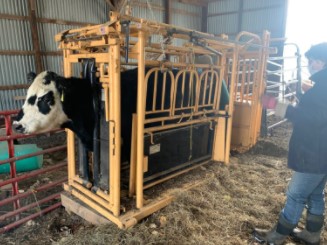By Rich Taber
This is the third installment in a multi-part series on raising beef cattle on the small farm. Previous installments can be viewed in the Summer and Fall editions of Cornell Small Farms Quarterly. This article will bring to your attention some equipment considerations that you must take in efficiently feeding your beef cattle and safely handling them.
The first thing to be considered is feeding equipment. What with our long winters in the Northeast, we typically end up feeding stored dry hay or baleage for about six months of the year. Many beef producers end up feeding these hay crops in large square or round bale form; some folks still feed small square bales too. All forms of livestock will waste a certain percentage of feed. We attempt to minimize this from happening with the judicious choice of mangers and feeders. We want to achieve maximum benefit to the animals and ensure their safety as well as for humans too.
If you were to just go out into the barnyard and dump hay without using feeders, in a short time a huge percentage of the feed would be wasted. We also want feeders that can be moved readily with a tractor front end loader, so that we don’t create a quagmire of mud and manure in the barnyard from feeding in the same location day after day. You might ask, but what about bale grazing? Bale grazing is a viable feeding method whereby bales are placed way out in pastures with the string, or netwrap, and plastic removed from them. The cows feed on them, and much of the waste is returned to the soil as fertilizer and manure. This is a viable technique, indeed, but not for the barnyard. Some people also have good success with rolling out their bales, either by hand or with a special device that unwinds the bales onto the ground. This is also a viable technique in the right place and time.
But back to the barnyard, where we are trying to prevent mud and manure buildup and are not concerned with bale grazing or unrolling. Much, if not all waste can be prevented by putting bales in rugged, well-built feeders. Cattle are anything but delicate creatures, hence the oft-quoted “bull in a china shop” description. Many producers use the “ring” type feeders available from many vendors, especially the “big box” farm supply stores. These are OK for a while but before too long they typically get smashed into scrap metal by the animals and from moving them with the tractor front end loader spear. They typically cost about $300, but they do not last too many years.
I have had much more success with simple, heavy-duty rectangular feeders, on their own skids that I get from a local vendor. They are designed to hold one to four bales and start out in price at about $1000 and up, depending on size. There are also feeders built with extra design features to cradle the bales in the feeder to further prevent waste, but at a higher price. I like the kind without wheels on them, as I can gently flip them over when I want to clean them out, by using a round bale on the front end loader and gently flipping them over, emptying the spoiled hay out, and rolling them one more time back upright. Of course, to feed heavy round or big square bales you have to have a reasonably good-sized tractor with a front end loader and preferably with four wheel drive. With all of the mud, muck, mire, snow, slop, frozen ruts, etc. that we accumulate in our northeastern winters you will soon discover the folly of trying to ram around through all of these evil conditions with just a two–wheel drive tractor with a heavy bale on a front end loader!
